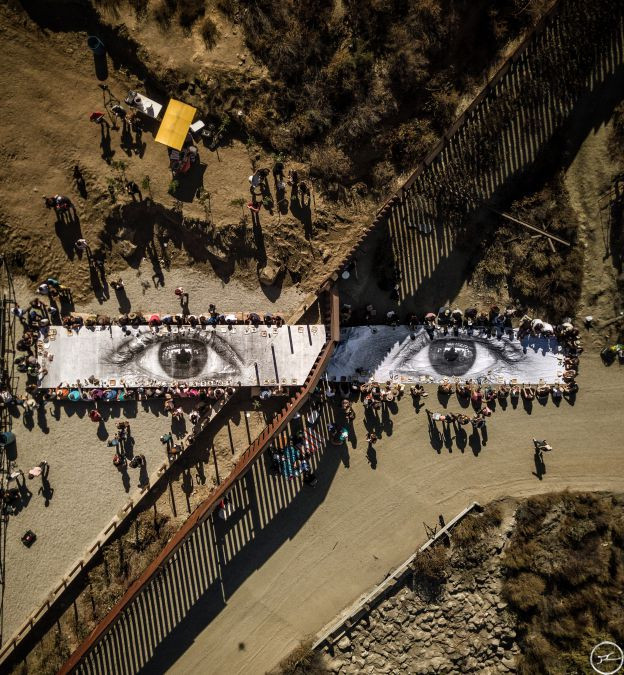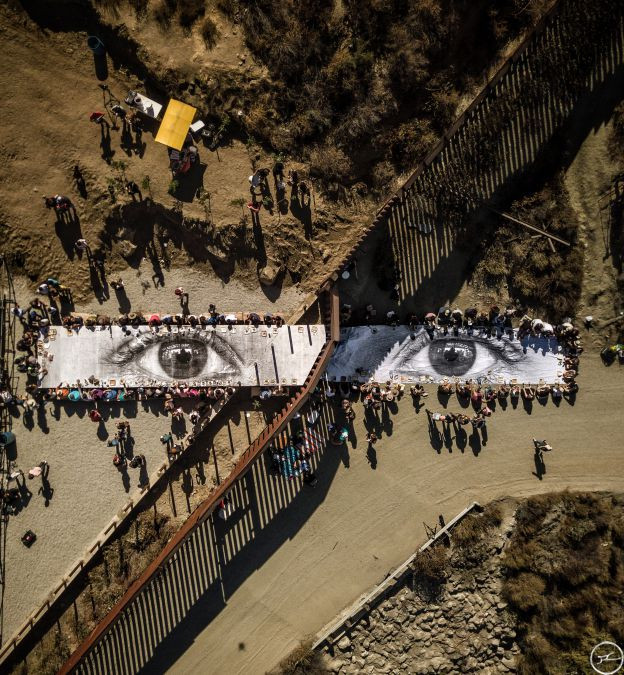
JR is one of the most famous street artists and photographers. He creates large-scale projects in the world capitals such as Berlin, Paris, London, and in the conflict zones, for example, on the border of Mexico and the United States. The main characters of his works are always ordinary people. Recently, Time magazine named JR one of the world's most influential people and wrote that "his art is changing the way we perceive ourselves."

As a teenager, JR drew the first graffiti on the streets of Paris and in the subway. At the age of 17 he began to film the process on camera and upload it to the network. ‘I painted graffiti: I painted my name wherever I could, using the city as a canvas. I climbed the tunnels and the roofs of Paris with my friends’ – the artist himself recalls.
In 2004, JR began work on his first large-scale project, Portraits of a Generation. The idea was to place portraits of young citizens on the streets of Paris. Part of the "Portraits of a Generation" was his reaction to the wave of protests in 2005 over the murder of two migrant teenagers in Paris. Then he posted four portraits of protesters, which were later shown by the city authorities in the administration building.
JR never signs his work. He also never reveals his real name. In an interview with The Guardian, he explained: “The fact that I remain anonymous gives me the opportunity to exhibit where I want. Nobody knows my name, which means I can easily travel wherever I want.” The publication itself emphasizes that while most graffiti artists leave their name on empty walls, JR recreates the identity of those whose names we usually do not know – ordinary people.
JR's works can be found in galleries and museums, but he still prefers the streets. In his opinion, it is really possible to get through to people only there, and not in the premises. So, he manages to reach people outside the crowd of those who are already interested in art.
Among the main topics that the artist raises are social equality, war and its consequences, and migration. One of the projects, for example, was exclusively feminist ‘Women are Heroes’. To do this, JR traveled to world hotspots such as Sierra Leone, Liberia, Kenya, Brazil, India and Cambodia, where he filmed women who face death on a daily basis. ‘I realized that in places where I have done projects before, men are on the streets with weapons, but these are women who hold the community together’ – JR.
In 2010, JR received the TED Award and $100,000 cash prize. The award is given to activists and artists who are making a difference in the world.
In 2015, the first fundamental monograph on the artist's work was published jointly with Nata Thompson. It is called ‘Can art change the world?’. This book contains all of the artist's current works and collaborations, previously unpublished behind-the-scenes footage from his studios in Paris and New York, and a graphic novel about the early days of artist Joseph Remnant.
In 2018, Time magazine named him one of the 100 most influential people of 2018. ‘JR's art changes the way we perceive ourselves. His impact on the world may be much greater than we can imagine yet’, – the editors explained their decision.
After receiving the TED award, JR announced the launch of the project ‘Inside Out’. The idea was that photographers anywhere in the world could send their work and get support as advice or money for its implementation. A year later, JR summed up the project at the TED Talk. As of 2012, the project covered 127 countries.
In Tunisia, a team of photographers created over 1,000 portraits to cover images of dictator Ben Ali. Another artist traveled to all Russian embassies in Europe to raise the issue of the rights of the LGBTQ+ community in the country. In the US, the artist made portraits of Native Americans to draw attention to the restriction of their rights in the Dakota. In Iran, an artist calling himself Abololo resisted the current government by making a portrait of a woman.
‘Art cannot change the world in a practical sense, but it can change perception. Art can change the way we see this world. Art can create an analogy. The fact that art cannot affect practical things makes it a neutral platform for exchanges and discussions, which further helps to change the world’, – JR said.
Since the beginning of the project ‘Face to Face’, JR has chosen Berlin as one of the key cities for his works. In 2013, he created the ‘Wrinkles of the City’ photo project. He created murals with the faces of elderly Berliners in different parts of the city.
In 2018, at the Brandenburg Gate, JR installed a photo of the fall of the wall taken by Iris Hesse at the end of 1989. The choice of location is not accidental: in the period from 1961 to 1989, the gate was part of the wall, which blocked access to the sights for both residents of the FRG and the residents of the GDR. After the fall of the wall, this place became a symbol of a united Berlin.
‘The Brandenburg Gate was part of a wall that represented the division of Europe after the failure of the ideology of mass murder. They separated women and men who lived in opposite systems of thought. The opening of these gates set off a wind of freedom that swept millions of Europeans’, – JR said.
For the Olympics in Rio de Janeiro in 2016, JR created the installation ‘Giants’. Throughout the city, he placed huge black-and-white figures of athletes in motion and inscribed them in the urban landscape. Later, in 2018, JR presented a similar figure in London.
In 2017, on the border between the US and Mexico, JR created an installation with a little boy who looks over the fence with interest, watching the territory of the States. ‘When Trump started talking a lot about the facilities on the border with Mexico, one day I saw a child peeking out from behind the wall. I wondered what the child was thinking about? What would any child think about? We know that at this age children do not have any political views, he does not see the wall the way we see it’, – JR said. Month later JR returned to the border and set up a photograph of the eyes of an illegal migrant, one part of the picture was located on one side of the border, and the second on the other. A picnic was organized there for everyone.
In 2018, JR created a cover for the Time magazine based on his own mural. It was called ‘Guns in America’. To do this, JR traveled through three states and photographed 245 people (politicians, activists, victims of guns, doctors and others) who represented different sides of the discussion about gun ownership.
In addition to working with installations and photography, JR's track record also includes collaborations with ballet. In 2014, the New York City Ballet invited him to become a member of the NYCB Art Series project. Every year the troupe invites one of the artists to work in a joint production. With JR, they created the ‘Eye photography project’ and later made the short film ‘Les bosquets’, which was scored by Hans Zimmer, Pharrell Williams and Woodkid.
